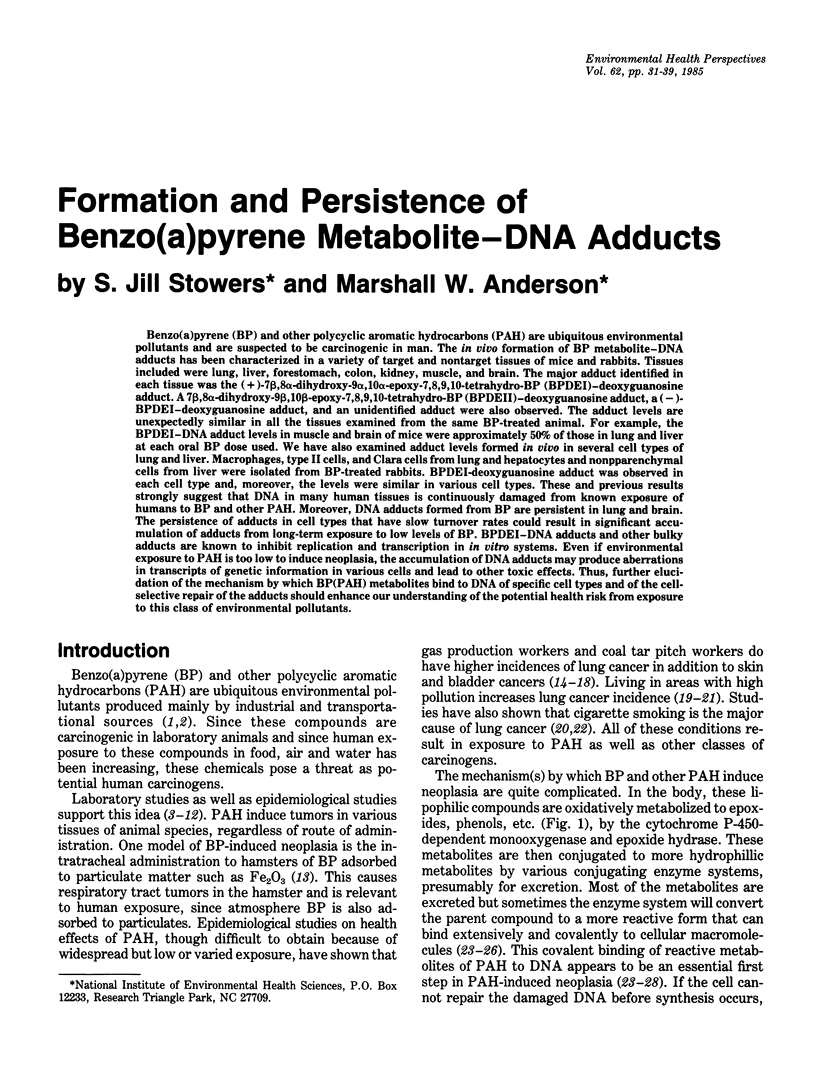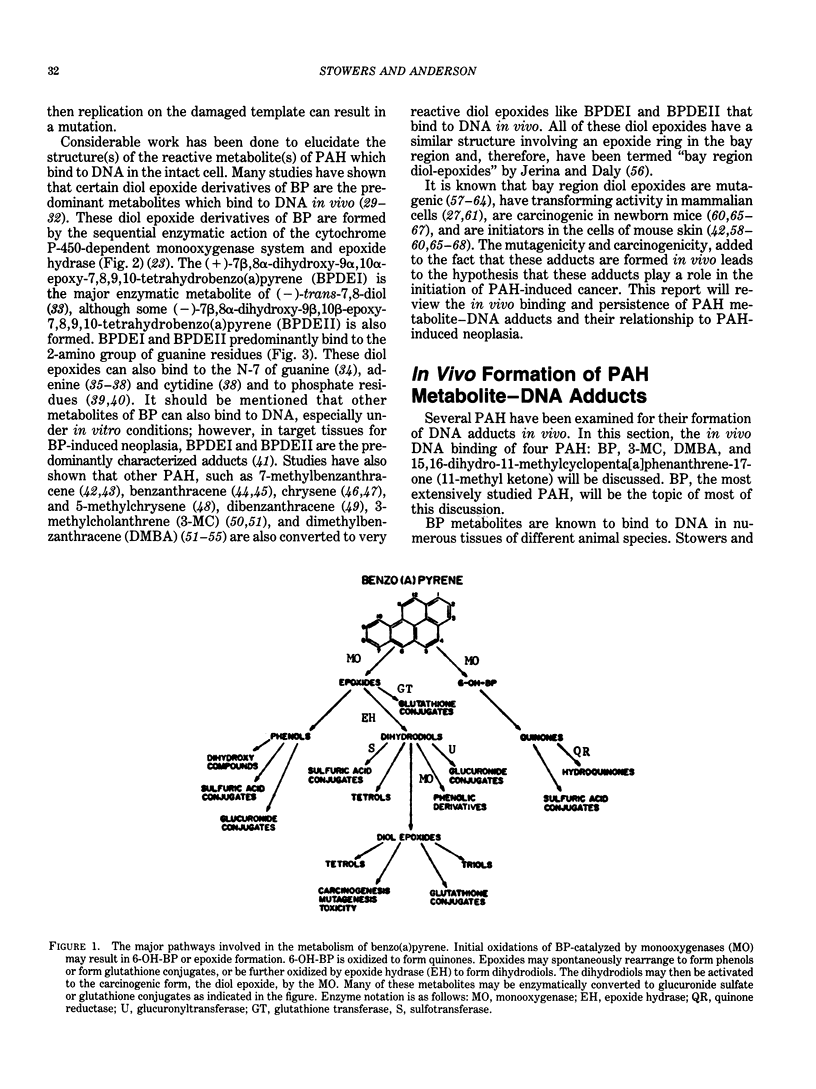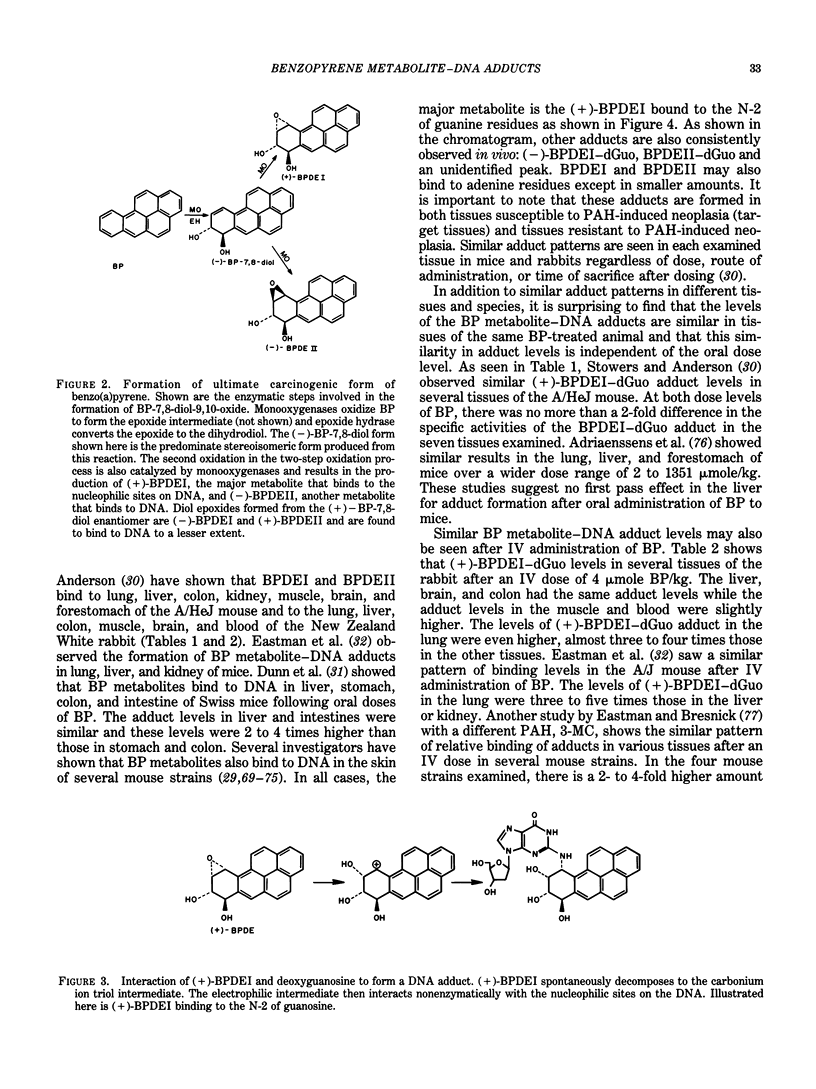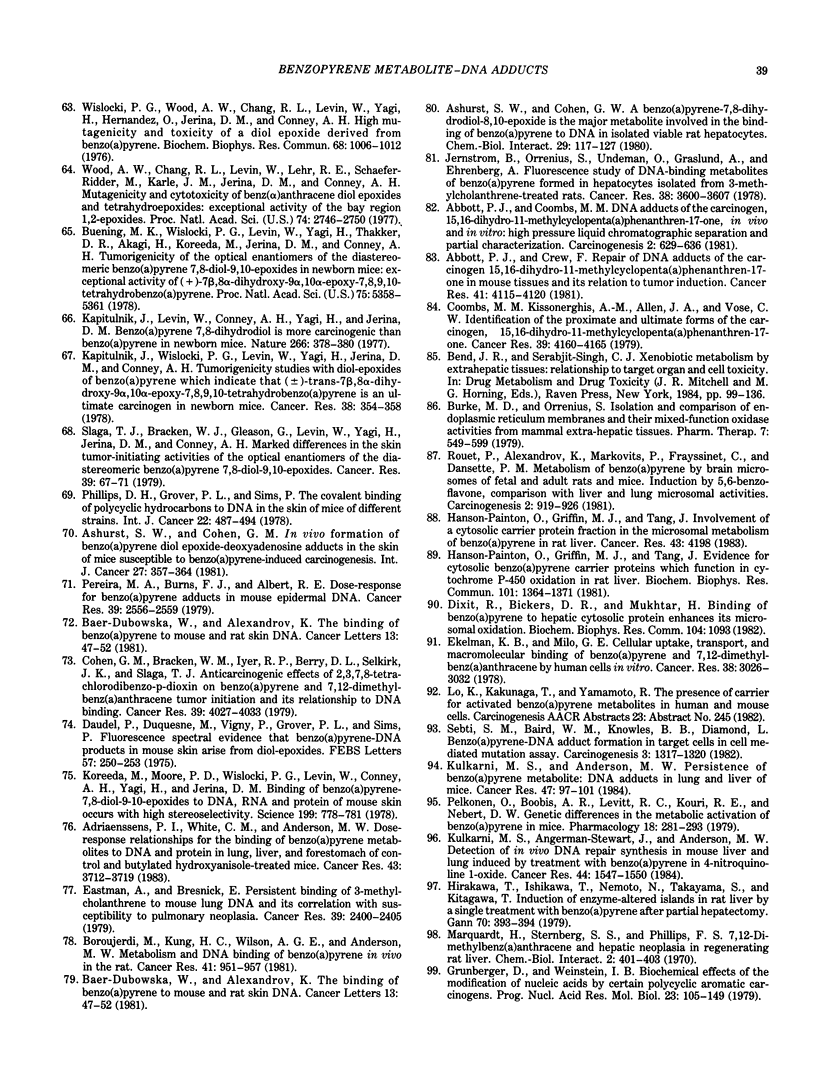Abstract
Benzo(a)pyrene (BP) and other polycyclic aromatic hydrocarbons (PAH) are ubiquitous environmental pollutants and are suspected to be carcinogenic in man. The in vivo formation of BP metabolite-DNA adducts has been characterized in a variety of target and nontarget tissues of mice and rabbits. Tissues included were lung, liver, forestomach, colon, kidney, muscle, and brain. The major adduct identified in each tissue was the (+)-7 beta,8 alpha-dihydroxy-9 alpha,10 alpha-epoxy-7,8,9,10-tetrahydro-BP (BPDEI)-deoxyguanosine adduct. A 7 beta, 8 alpha-dihydroxy-9 beta,10 beta-epoxy-7,8,9,10-tetrahydro-BP (BPDEII)-deoxyguanosine adduct, a (-)-BPDEI-deoxyguanosine adduct, and an unidentified adduct were also observed. The adduct levels are unexpectedly similar in all the tissues examined from the same BP-treated animal. For example, the BPDEI-DNA adduct levels in muscle and brain of mice were approximately 50% of those in lung and liver at each oral BP dose used. We have also examined adduct levels formed in vivo in several cell types of lung and liver. Macrophages, type II cells, and Clara cells from lung and hepatocytes and nonpparenchymal cells from liver were isolated from BP-treated rabbits. BPDEI-deoxyguanosine adduct was observed in each cell type and, moreover, the levels were similar in various cell types. These and previous results strongly suggest that DNA in many human tissues is continuously damaged from known exposure of humans to BP and other PAH. Moreover, DNA adducts formed from BP are persistent in lung and brain.(ABSTRACT TRUNCATED AT 250 WORDS)
Full text
PDF








Selected References
These references are in PubMed. This may not be the complete list of references from this article.
- Abbott P. J., Coombs M. M. DNA adducts of the carcinogen, 15,16-dihydro-11-methylcyclopenta[a]phenanthren-17-one, in vivo and in vitro: high pressure liquid chromatographic separation and partial characterization. Carcinogenesis. 1981;2(7):629–636. doi: 10.1093/carcin/2.7.629. [DOI] [PubMed] [Google Scholar]
- Abbott P. J., Crew F. Repair of DNA adducts of the carcinogen 15,16-dihydro-11-methylcyclopenta[a]phenanthren-17-one in mouse tissues and its relation to tumor induction. Cancer Res. 1981 Oct;41(10):4115–4120. [PubMed] [Google Scholar]
- Adriaenssens P. I., White C. M., Anderson M. W. Dose-response relationships for the binding of benzo(a)pyrene metabolites to DNA and protein in lung, liver, and forestomach of control and butylated hydroxyanisole-treated mice. Cancer Res. 1983 Aug;43(8):3712–3719. [PubMed] [Google Scholar]
- Ashurst S. W., Cohen G. M. A benzo[alpha]pyrene-7,8-dihydrodiol-9,10-epoxide is the major metabolite involved in the binding of benzo[alpha]pyrene to DNA in isolated viable rat hepatocytes. Chem Biol Interact. 1980 Jan;29(1):117–127. doi: 10.1016/0009-2797(80)90091-5. [DOI] [PubMed] [Google Scholar]
- Ashurst S. W., Cohen G. M. In vivo formation of benzo(alpha)pyrene diol epoxide-deoxyadenosine adducts in the skin of mice susceptible to benzo(alpha)pyrene-induced carcinogenesis. Int J Cancer. 1981 Mar 15;27(3):357–364. doi: 10.1002/ijc.2910270315. [DOI] [PubMed] [Google Scholar]
- Ayres S. M., Buehler M. E. The effects of urban air pollution on health. Clin Pharmacol Ther. 1970 May-Jun;11(3):337–371. doi: 10.1002/cpt1970113337. [DOI] [PubMed] [Google Scholar]
- Baer-Dubowska W., Alexandrov K. The binding of benzo[a]pyrene to mouse and rat skin DNA. Cancer Lett. 1981 Jun;13(1):47–52. doi: 10.1016/0304-3835(81)90085-9. [DOI] [PubMed] [Google Scholar]
- Baer-Dubowska W., Alexandrov K. The binding of benzo[a]pyrene to mouse and rat skin DNA. Cancer Lett. 1981 Jun;13(1):47–52. doi: 10.1016/0304-3835(81)90085-9. [DOI] [PubMed] [Google Scholar]
- Baird W. M., Dipple A. Photosensitivity of DNA-bound 7,12-dimethylbenz(alpha)anthracene. Int J Cancer. 1977 Sep 15;20(3):427–431. doi: 10.1002/ijc.2910200315. [DOI] [PubMed] [Google Scholar]
- Baird W. M., Harvey R. G., Brookes P. Comparison of the cellular DNA-bound products of benzo(alpha)pyrene with the products formed by the reaction of benzo(alpha)pyrene-4,5-oxide with DNA. Cancer Res. 1975 Jan;35(1):54–57. [PubMed] [Google Scholar]
- Boroujerdi M., Kung H., Wilson A. G., Anderson M. W. Metabolism and DNA binding of benzo(a)pyrene in vivo in the rat. Cancer Res. 1981 Mar;41(3):951–957. [PubMed] [Google Scholar]
- Buening M. K., Wislocki P. G., Levin W., Yagi H., Thakker D. R., Akagi H., Koreeda M., Jerina D. M., Conney A. H. Tumorigenicity of the optical enantiomers of the diastereomeric benzo[a]pyrene 7,8-diol-9,10-epoxides in newborn mice: exceptional activity of (+)-7beta,8alpha-dihydroxy-9alpha,10alpha-epoxy-7,8,9,10-tetrahydrobenzo[a]pyrene. Proc Natl Acad Sci U S A. 1978 Nov;75(11):5358–5361. doi: 10.1073/pnas.75.11.5358. [DOI] [PMC free article] [PubMed] [Google Scholar]
- Burke M. D., Orrenius S. Isolation and comparison of endoplasmic reticulum membranes and their mixed function oxidase activities from mammalian extrahepatic tissues. Pharmacol Ther. 1979;7(3):549–599. doi: 10.1016/0163-7258(79)90042-1. [DOI] [PubMed] [Google Scholar]
- Cohen G. M., Bracken W. M., Iyer R. P., Berry D. L., Selkirk J. K., Slaga T. J. Anticarcinogenic effects of 2,3,7,8-tetrachlorodibenzo-p-dioxin on benzo(a)pyrene and 7,12-dimethylbenz(a)anthracene tumor initiation and its relationship to DNA binding. Cancer Res. 1979 Oct;39(10):4027–4033. [PubMed] [Google Scholar]
- Coombs M. M., Kissonerghis A. M., Allen J. A., Vose C. W. Identification of the proximate and ultimate forms of the carcinogen 15,16-dihydro-11-methylcyclopenta[a]phenanthren-17-one. Cancer Res. 1979 Oct;39(10):4160–4165. [PubMed] [Google Scholar]
- Daudel P., Duquesne M., Vigny P., Grover P. L., Sims P. Fluorescence spectral evidence that benzo(a)pyrene-DNA products in mouse skin arise from diol-epoxides. FEBS Lett. 1975 Oct 1;57(3):250–253. doi: 10.1016/0014-5793(75)80310-3. [DOI] [PubMed] [Google Scholar]
- Dipple A., Nebzydoski J. A. Evidence for the involvement of a diol-epoxide in the binding of 7,12-dimethylbenz(a)anthracene to DNA in cells in culture. Chem Biol Interact. 1978 Jan;20(1):17–26. doi: 10.1016/0009-2797(78)90077-7. [DOI] [PubMed] [Google Scholar]
- Dixit R., Bickers D. R., Mukhtar H. Binding of benzo(a)pyrene to hepatic cytosolic protein enhances its microsomal oxidation. Biochem Biophys Res Commun. 1982 Feb 11;104(3):1093–1101. doi: 10.1016/0006-291x(82)91362-6. [DOI] [PubMed] [Google Scholar]
- Dunn B. P. Wide-range linear dose-response curve for DNA binding of orally administered benzo(a)pyrene in mice. Cancer Res. 1983 Jun;43(6):2654–2658. [PubMed] [Google Scholar]
- Eastman A., Bresnick E. Persistent binding of 3-methylcholanthrene to mouse lung DNA and its correlation with susceptibility to pulmonary neoplasia. Cancer Res. 1979 Jul;39(7 Pt 1):2400–2405. [PubMed] [Google Scholar]
- Eastman A., Sweetenham J., Bresnick E. Comparison of in vivo and in vitro binding of polycyclic hydrocarbons to DNA. Chem Biol Interact. 1978 Dec;23(3):345–353. doi: 10.1016/0009-2797(78)90095-9. [DOI] [PubMed] [Google Scholar]
- Ekelman K. B., Milo G. E. Cellular uptake, transport, and macromolecular binding of benzo(a)pyrene and 7,12-dimethylbenz(a)anthracene by human cells in vitro. Cancer Res. 1978 Sep;38(9):3026–3032. [PubMed] [Google Scholar]
- Gelboin H. V. Benzo[alpha]pyrene metabolism, activation and carcinogenesis: role and regulation of mixed-function oxidases and related enzymes. Physiol Rev. 1980 Oct;60(4):1107–1166. doi: 10.1152/physrev.1980.60.4.1107. [DOI] [PubMed] [Google Scholar]
- Grover P. L., Hewer A., Pal K., Sims P. The involvement of a diol-epoxide in the metabolic activation of benzo(a)pyrene in human bronchial mucosa and in mouse skin. Int J Cancer. 1976 Jul 15;18(1):1–6. doi: 10.1002/ijc.2910180102. [DOI] [PubMed] [Google Scholar]
- Grunberger D., Weinstein I. B. Biochemical effects of the modification of nucleic acids by certain polycyclic aromatic carcinogens. Prog Nucleic Acid Res Mol Biol. 1979;23:105–149. doi: 10.1016/s0079-6603(08)60132-4. [DOI] [PubMed] [Google Scholar]
- Hanson-Painton O., Griffin M. J., Tang J. Evidence for cytosolic benzo(a)pyrene carrier proteins which function in cytochrome P450 oxidation in rat liver. Biochem Biophys Res Commun. 1981 Aug 31;101(4):1364–1371. doi: 10.1016/0006-291x(81)91598-9. [DOI] [PubMed] [Google Scholar]
- Hanson-Painton O., Griffin M. J., Tang J. Involvement of a cytosolic carrier protein fraction in the microsomal metabolism of benzo(a)pyrene in rat liver. Cancer Res. 1983 Sep;43(9):4198–4206. [PubMed] [Google Scholar]
- Hecht S. S., LaVoie E., Mazzarese R., Amin S., Bedenko V., Hoffmann D. 1,2-dihydro-1,2-dihydroxy-5-methylchrysene, a major activated metabolite of the environmental carcinogen 5-methylchrysene. Cancer Res. 1978 Jul;38(7):2191–2194. [PubMed] [Google Scholar]
- Heidelberger C. Chemical carcinogenesis. Annu Rev Biochem. 1975;44:79–121. doi: 10.1146/annurev.bi.44.070175.000455. [DOI] [PubMed] [Google Scholar]
- Henderson B. E., Gordon R. J., Menck H., Soohoo J., Martin S. P., Pike M. C. Lung cancer and air pollution in southcentral Los Angeles County. Am J Epidemiol. 1975 Jun;101(6):477–488. doi: 10.1093/oxfordjournals.aje.a112118. [DOI] [PubMed] [Google Scholar]
- Henry M. C., Port C. D., Kaufman D. G. Importance of physical properties of benzo(a)pyrene-ferric oxide mixtures in lung tumor induction. Cancer Res. 1975 Jan;35(1):207–217. [PubMed] [Google Scholar]
- Hirakawa T., Ishikawa T., Nemoto N., Takayama S., Kitagawa T. Induction of enzyme-altered islands in rat liver by a single treatment with benzo[a]pyrene after partial hepatectomy. Gan. 1979 Jun;70(3):393–394. [PubMed] [Google Scholar]
- Huberman E., Sachs L., Yang S. K., Gelboin V. Identification of mutagenic metabolites of benzo(a)pyrene in mammalian cells. Proc Natl Acad Sci U S A. 1976 Feb;73(2):607–611. doi: 10.1073/pnas.73.2.607. [DOI] [PMC free article] [PubMed] [Google Scholar]
- Ivanovic V., Geacintov N. E., Jeffrey A. M., Fu P. P., Harvey R. G., Weinstein I. B. Cell and microsome mediated binding of 7,12-dimethylbenz(a)anthracene to DNA studied by fluorescence spectroscopy. Cancer Lett. 1978 Mar;4(3):131–140. doi: 10.1016/s0304-3835(78)93962-9. [DOI] [PubMed] [Google Scholar]
- Kakefuda T., Yamamoto H. Modification of DNA by the benzo[a]pyrene metabolite diol-epoxide r-7,t-8-dihydroxy-t-9,10-oxy-7,8,9,10-tetrahydrobenzo[a]pyrene. Proc Natl Acad Sci U S A. 1978 Jan;75(1):415–419. doi: 10.1073/pnas.75.1.415. [DOI] [PMC free article] [PubMed] [Google Scholar]
- Kapitulnik J., Levin W., Conney A. H., Yagi H., Jerina D. M. Benzo[a]pyrene 7,8-dihydrodiol is more carcinogenic than benzo[a]pyrene in newborn mice. Nature. 1977 Mar 24;266(5600):378–380. doi: 10.1038/266378a0. [DOI] [PubMed] [Google Scholar]
- Kapitulnik J., Wislocki P. G., Levin W., Yagi H., Jerina D. M., Conney A. H. Tumorigenicity studies with diol-epoxides of benzo(a)pyrene which indicate that (+/-)-trans-7beta,8alpha-dihydroxy-9alpha,10alpha-epoxy-7,8,9,10-tetrahydrobenzo(a)pyrene is an ultimate carcinogen in newborn mice. Cancer Res. 1978 Feb;38(2):354–358. [PubMed] [Google Scholar]
- Kendrick J., Nettesheim P., Hammons A. S. Tumor induction in tracheal grafts: a new experimental model for respiratory carcinogenesis studies. J Natl Cancer Inst. 1974 Apr;52(4):1317–1325. doi: 10.1093/jnci/52.4.1317. [DOI] [PubMed] [Google Scholar]
- King H. W., Osborne M. R., Brookes P. The metabolism and DNA binding of 3-methyl-cholanthrene. Int J Cancer. 1977 Oct 15;20(4):564–571. doi: 10.1002/ijc.2910200414. [DOI] [PubMed] [Google Scholar]
- Kitagawa T., Hirakawa T., Ishikawa T., Nemoto N., Takayama S. Induction of hepatocellular carcinoma in rat liver by initial treatment with benzo(a)pyrene after partial hepatectomy and promotion by phenobarbital. Toxicol Lett. 1980 Aug;6(3):167–171. doi: 10.1016/0378-4274(80)90186-1. [DOI] [PubMed] [Google Scholar]
- Koreeda M., Moore P. D., Wislocki P. G., Levin W., Yagi H., Jerina D. M. Binding of benzo[a]pyrene 7,8-diol-9,10-epoxides to DNA, RNA, and protein of mouse skin occurs with high stereoselectivity. Science. 1978 Feb 17;199(4330):778–781. doi: 10.1126/science.622566. [DOI] [PubMed] [Google Scholar]
- Koreeda M., Moore P. D., Yagi H., Yeh H. J., Jerina D. M. Alkylation of polyguanylic acid at the 2-amino group and phosphate by the potent mutagen (+/-)-7beta,8alpha-dihydroxy-9beta,10beta-epoxy-7,8,9,10-tetrahydrobenzo[a]pyrene. J Am Chem Soc. 1976 Oct 13;98(21):6720–6722. doi: 10.1021/ja00437a061. [DOI] [PubMed] [Google Scholar]
- Kulkarni M. S., Anderson M. W. Persistence of benzo(a)pyrene metabolite:DNA adducts in lung and liver of mice. Cancer Res. 1984 Jan;44(1):97–101. [PubMed] [Google Scholar]
- Kulkarni M. S., Angerman-Stewart J., Anderson M. W. Detection of in vivo DNA repair synthesis in mouse liver and lung induced by treatment with benzo(a)pyrene or 4-nitroquinoline 1-oxide. Cancer Res. 1984 Apr;44(4):1547–1550. [PubMed] [Google Scholar]
- Levin W., Wood A. W., Chang R. L., Yagi H., Mah H. D., Jerina D. M., Conney A. H. Evidence for bay region activation of chrysene 1,2-dihydrodiol to an ultimate carcinogen. Cancer Res. 1978 Jun;38(6):1831–1834. [PubMed] [Google Scholar]
- Marquardt H., Baker S., Grover P. L., Sims P. Malignant transformation and mutagenesis in mammalian cells induced by vicinal diol-epoxides derived from benzo(a)pyrene. Cancer Lett. 1977 Jul;3(1-2):31–36. doi: 10.1016/s0304-3835(77)93906-4. [DOI] [PubMed] [Google Scholar]
- Marquardt H., Baker S., Tierney B., Grover P. L., Sims P. The metabolic activation of 7-methylbenz(a)anthracene: the induction of malignant transformation and mutation in mammalian cells by non-K-region dihydrodiols. Int J Cancer. 1977 Jun 15;19(6):828–833. doi: 10.1002/ijc.2910190614. [DOI] [PubMed] [Google Scholar]
- Marquardt H., Sternberg S. S., Philips F. S. 7,12-dimethylbenz(a)anthracene and hepatic neoplasia in regenerating rat liver. Chem Biol Interact. 1970 Dec;2(4):401–403. doi: 10.1016/0009-2797(70)90060-8. [DOI] [PubMed] [Google Scholar]
- McCann J., Ames B. N. Detection of carcinogens as mutagens in the Salmonella/microsome test: assay of 300 chemicals: discussion. Proc Natl Acad Sci U S A. 1976 Mar;73(3):950–954. doi: 10.1073/pnas.73.3.950. [DOI] [PMC free article] [PubMed] [Google Scholar]
- Meehan T., Straub K., Calvin M. Benzo[alpha]pyrene diol epoxide covalently binds to deoxyguanosine and deoxyadenosine in DNA. Nature. 1977 Oct 20;269(5630):725–727. doi: 10.1038/269725a0. [DOI] [PubMed] [Google Scholar]
- Moschel R. C., Baird W. M., Dipple A. Metabolic activation of the carcinogen 7,12-dimethylbenz[a]anthracene for DNA binding. Biochem Biophys Res Commun. 1977 Jun 20;76(4):1092–1098. doi: 10.1016/0006-291x(77)90968-8. [DOI] [PubMed] [Google Scholar]
- Newbold R. F., Brookes P. Exceptional mutagenicity of a benzo(a)pyrene diol epoxide in cultured mammalian cells. Nature. 1976 May 6;261(5555):52–54. doi: 10.1038/261052a0. [DOI] [PubMed] [Google Scholar]
- Osborne M. R., Harvey R. G., Brookes P. The reaction of trans-7,8-dihydroxy-anti-9,10-epoxy-7,8,9,10-tetrahydrobenzo(a)pyrene with DNA involves attack at the N7-position of guanine moieties. Chem Biol Interact. 1978 Jan;20(1):123–130. doi: 10.1016/0009-2797(78)90087-x. [DOI] [PubMed] [Google Scholar]
- Pelkonen O., Boobis A. R., Levitt R. C., Kouri R. E., Nebert D. W. Genetic differences in the metabolic activation of benzo[a]pyrene in mice. Attempts to correlate tumorigenesis with binding of reactive intermediates to DNA and with mutagenesis in vitro. Pharmacology. 1979;18(6):281–293. doi: 10.1159/000137267. [DOI] [PubMed] [Google Scholar]
- Pereira M. A., Burns F. J., Albert R. E. Dose response for benzo(a)pyrene adducts in mouse epidermal DNA. Cancer Res. 1979 Jul;39(7 Pt 1):2556–2559. [PubMed] [Google Scholar]
- Phillips D. H., Grover P. L., Sims P. The covalent binding of polycyclic hydrocarbons to DNA in the skin of mice of different strains. Int J Cancer. 1978 Oct 15;22(4):487–494. doi: 10.1002/ijc.2910220419. [DOI] [PubMed] [Google Scholar]
- Rouet P., Alexandrov K., Markovits P., Frayssinet C., Dansette P. M. Metabolism of benzo[a]pyrene by brain microsomes of fetal and adult rats and mice. Induction by 5,6 benzoflavone, comparison with liver and lung microsomal activities. Carcinogenesis. 1981;2(9):919–926. doi: 10.1093/carcin/2.9.919. [DOI] [PubMed] [Google Scholar]
- Saffiotti U., Cefis F., Kolb L. H. A method for the experimental induction of bronchogenic carcinoma. Cancer Res. 1968 Jan;28(1):104–124. [PubMed] [Google Scholar]
- Sebti S. M., Baird W. M., Knowles B. B., Diamond L. Benzo[a]pyrene--DNA adduct formation in target cells in a cell-mediated mutation assay. Carcinogenesis. 1982;3(11):1317–1320. doi: 10.1093/carcin/3.11.1317. [DOI] [PubMed] [Google Scholar]
- Slaga T. J., Bracken W. J., Gleason G., Levin W., Yagi H., Jerina D. M., Conney A. H. Marked differences in the skin tumor-initiating activities of the optical enantiomers of the diastereomeric benzo(a)pyrene 7,8-diol-9,10-epoxides. Cancer Res. 1979 Jan;39(1):67–71. [PubMed] [Google Scholar]
- Slaga T. J., Huberman E., Selkirk J. K., Harvey R. G., Bracken W. M. Carcinogenicity and mutagenicity of benz(a)anthracene diols and diol-epoxides. Cancer Res. 1978 Jun;38(6):1699–1704. [PubMed] [Google Scholar]
- Slaga T. J., Viaje A., Betty D. L., Brachen W., Buty S. G., Scribner J. D. Skin tumor initiating ability of benzo(a)pyrene 4,5- 7,5- and 7,8-diol-9,10-epoxides and 7,8-diol. Cancer Lett. 1976 Nov;2(2):115–121. doi: 10.1016/s0304-3835(76)80020-1. [DOI] [PubMed] [Google Scholar]
- Stowers S. J., Anderson M. W. Ubiquitous binding of benzo[a]pyrene metabolites to DNA and protein in tissues of the mouse and rabbit. Chem Biol Interact. 1984 Sep 15;51(2):151–166. doi: 10.1016/0009-2797(84)90027-9. [DOI] [PubMed] [Google Scholar]
- Straub K. M., Meehan T., Burlingame A. L., Calvin M. Identification of the major adducts formed by reaction of benzo(a)pyrene diol epoxide with DNA in vitro. Proc Natl Acad Sci U S A. 1977 Dec;74(12):5285–5289. doi: 10.1073/pnas.74.12.5285. [DOI] [PMC free article] [PubMed] [Google Scholar]
- Vigny P., Duquesne M., Coulomb H., Tierney B., Grover P. L., Sims P. Fluorescence spectral studies on the metabolic activation of 3-methylcholanthrene and 7,12-dimethylbenz[a]anthracene in mouse skin. FEBS Lett. 1977 Oct 15;82(2):278–282. doi: 10.1016/0014-5793(77)80602-9. [DOI] [PubMed] [Google Scholar]
- Wislocki P. G., Wood A. W., Chang R. L., Levin W., Yagi H., Hernandez O., Jerina D. M., Conney A. H. High mutagenicity and toxicity of a diol epoxide derived from benzo(a)pyrene. Biochem Biophys Res Commun. 1976 Feb 9;68(3):1006–1012. doi: 10.1016/0006-291x(76)91246-8. [DOI] [PubMed] [Google Scholar]
- Wood A. W., Chang R. L., Levin W., Lehr R. E., Schaefer-Ridder M., Karle J. M., Jerina D. M., Conney A. H. Mutagenicity and cytotoxicity of benz[alpha]anthracene diol epoxides and tetrahydro-epoxides: exceptional activity of the bay region 1,2-epoxides. Proc Natl Acad Sci U S A. 1977 Jul;74(7):2746–2750. doi: 10.1073/pnas.74.7.2746. [DOI] [PMC free article] [PubMed] [Google Scholar]
- Wood A. W., Levin W., Lu A. Y., Ryan D., West S. B., Lehr R. E., Schaefer-Ridder M., Jerina D. M., Conney A. H. Mutagenicity of metabolically activated benzo[a]anthracene 3,4-dihydrodiol: evidence for bay region activation of carcinogenic polycyclic hydrocarbons. Biochem Biophys Res Commun. 1976 Sep 20;72(2):680–686. doi: 10.1016/s0006-291x(76)80093-9. [DOI] [PubMed] [Google Scholar]
- Wood A. W., Levin W., Ryan D., Thomas P. E., Yagi H., Mah H. D., Thakker D. R., Jerina D. M., Conney A. H. High mutageniticity of metabolically activated chrysene 1,2 dihydrodiol: evidence for bay region activation of chrysene. Biochem Biophys Res Commun. 1977 Oct 10;78(3):847–854. doi: 10.1016/0006-291x(77)90500-9. [DOI] [PubMed] [Google Scholar]
- Wood A. W., Levin W., Thomas P. E., Ryan D., Karle J. M., Yagi H., Jerina D. M., Conney A. H. Metabolic activation of dibenzo(a,h)anthracene and its dihydrodiols to bacterial mutagens. Cancer Res. 1978 Jul;38(7):1967–1973. [PubMed] [Google Scholar]


